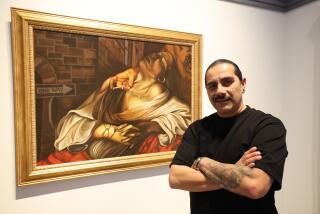In John Divola’s photographs, an elusive presence
A woman watering her lawn can be slightly sexy, but a silver butane tank can change a man’s life.
John Divola, a photographer in chase of the sublime, discerned this as a graduate student in a ponytail, peddling his bicycle and taking pictures of tract houses and women with hoses, snippets of suburbia in the morning light. It was the shine of a butane tank, however, that led him into an abandoned house with a can of silver paint and a new way, at least for him, of infusing the artist into his work.
He painted shapes on walls. Black and white spots followed. The images left the viewer wondering: Who did this? Why? The pictures linked the photographer with his subject as if the two were at work on a deft conspiracy. Divola’s photography — he has a multipart retrospective running in Los Angeles, Santa Barbara and Claremont — leaves the impression that he is in or has just left the frame.
PHOTOS: John Divola’s photography
His photographs and conceptual art are organic to Southern California — beaches, deserts, cities, mountains, the tug of light and at times a desolation playing amid a land of endless reinvention where human bonds can be provisional and many define themselves through the parade of popular culture. Divola’s work is a pause in the noise, an escape from the clamor.
He never expected to make a living from photography. What he was after, he said, was to tell himself on his deathbed that he’d found “something enriching ... a meaningful engagement” with the world. His tones and spatial dimensions instill a sadness, a longing to capture a beauty, whether a saltbox house at dusk or a black dog chasing a car, that to him remains evocatively elusive.
“I want [my photographs] to be seductive, but they’re also about unattainable desire,” he has said.
A tall man with a rumpled air, Divola, 64, has a long face and a gravelly, soothing voice, the kind one hears on the radio while driving across Nebraska in the pitch of night. His silver-brown hair is thick, almost plume-like; wrinkles arc back from his eyes, his hands are in no particular hurry. On the aging artist, he said, “You get older and you become a caricature of yourself.... It’s almost impossible to transcend it.”
He said of the retrospective: “I don’t look at it as a summing up, but it’s an ambitious presentation of my work.... I’m delighted.”
PHOTOS: Arts and culture in pictures by The Times
The son of an aeronautical engineer and a literature major, he speaks in sentences that can shift from “I’m inherently philosophical and interested in the existential” to “You’re out there in the desert knocking around on a dirt road.” He wonders if we can ever articulate what’s within and without us, what we see, feel, experience.
‘Complexity of experience’
Minutes earlier, Divola sat over coffee at a Venice café and told the man taking notes across the table: “I don’t trust the abstract nature of language. You’re going to write about this and it will be a bunch of words ... but it’s not the thing. The complexity of experience cannot be manifest in language or really in a photograph.”
Among his most characteristic works over the last four decades are “Zuma,” which cataloged the months-long deterioration of an abandoned beach house used by firefighters for training; “Dogs Chasing My Car in the Desert,” a collection of blurry and sharp images describing just what the title promises; “Isolated Houses,” a series of single-room homes (“painted in Home Depot colors”) that conjure lives and structures blending into yet simultaneously defiant of landscape; and “As Far as I Could Get,” a collection that depicts Divola sprinting away — as if an aberration — from a camera set to click after 10 seconds.
There’s a relentless quality to the man and his work. “For whatever reason I’ve become obsessed with this process,” said Divola, an art professor at UC Riverside. He added that teaching keeps him focused and in context: “It’s good to be around people who see it [photography] as a reasonable enterprise when everyone in the neighborhood may think it’s ridiculous.”
ART: Can you guess the high price?
In his review of the new shows, Times art critic Christopher Knight wrote that a “quietly emotional undercurrent is one element that distinguishes Divola’s art from contemporaneous work of such photographers as Lewis Baltz and Joe Deal, who also charted the human transformation of the modern industrial era and suburban landscape. Photographically, California had long been characterized by the epic work of Ansel Adams, pictorial poet of Yosemite. These and other artists pulled the plug on that.”
Counterculture influences
Among Divola’s earlier influences was a cadre of 1960s-inspired counterculture friends at Chatsworth High School in the San Fernando Valley. “One of them lived a whole year without touching money. He made us pies,” he said. “They were a group of very interesting people. I was the more conservative among them. I’ve always privileged logic.”
After receiving a bachelor’s degree from Cal State Northridge, Divola, who uses a range of equipment including a digital SLR and an 8-by-10 view camera, entered the master’s degree program at UCLA. He studied with Robert Heinecken, whose unconventionality stripped away the aura of sanctity around photographs, urging artists to intervene to depict the crassness of a society inured to commercialism.
“Nobody in my grad school was using a camera in a conventional sense,” said Divola, adding that he and others drifted toward the iconography and experimentation of Andy Warhol and others. “I could not establish a relationship to the iconography I was using and I didn’t want to be derivative.” That sent him “back to zero” and into neighborhoods where he photographed lawn waterers and other scenes that drew assumptions from some that he was portraying suburbia as abject and soulless.
REVIEW: It takes real drive to see 3-part John Divola retrospective
“I’ve never been interested in passing judgment,” he said. What he ended up finding was a way into an image, the fingerprints of the artist as part of the work itself. “I wanted the activity of moving through the landscape to be in the content, so that the process becomes an undeniable component,” he said.
Pictures in the series “Isolated Houses” show small homes rising out of the desert near Twentynine Palms. Some are in the foreground, some in the distance; there is the sense of the frontier, of a solitary stoicism surviving against and in harmony with the elements. One feels the quiet, the expanse early settlers must have felt when they glimpsed the copper landscape spread dreamlike before them. “The light of the desert seduced me,” he said.
The vacant house in the “Zuma” collection was repeatedly burned by firemen — Divola had originally thought it was the work of an “arsonist with a trunk load of trees” — and marked with the artist’s squiggly graffiti. It is a wreck, a decaying struture whose shattered windows open to orange-streaked skies and the crisp vastness of the ocean. At times, the house seems adrift, but in each shot, including a book that has taken flight amid the debris and charred walls, the artist is both present and complicit.
The trick with Divola — he fronts a slight smirk when he doesn’t like something — is to avoid metaphor. What does the flying book signify? “I just threw it up to see what it would look like.”
Does the ocean sky suggest ...? “The sky in ‘Zuma’ doesn’t represent anything for me,” said Divola, who has a daughter and lives in Riverside. “I don’t look for things to see how they function as metaphors.” He added that there’s “certainly a huge subjective component. Storms and sunsets are provocative and beautiful but also a cliché. ... You can’t photograph the sublime. You can only traffic in the specific and its relationship to the symbolic.”
GRAPHIC: Highest-earning art executives
Symbols mean different things to different cultures. When “Zuma” was exhibited in Asia, many Japanese, perhaps recalling the destruction and flash in the skies over Hiroshima and Nagasaki more than 60 years ago, saw it as apocalyptic. “I never thought that,” said Divola, pushing aside his empty coffee cup as Fauré’s requiem played amid a smattering of Christmas music.
He texted a message on his cellphone. He had a meeting in an hour with a French journalist and a Norwegian artist. “The French are really interested in Los Angeles,” he said. He is concerned that observation is increasingly supplanted by the virtual in a global, digital age in which tweets are harvested to market products and billions of photos move daily through cyberspace. Life in a whirl of altered perceptions so that the trick is staying free of an increasingly manipulated parallel universe.
“It all becomes testimonial,” he said, adding that corporations, government and religion can co-opt images to create new realities. “I’m a little worried about this. What happens when religion finds out about CGI [computer generated imagery] and the people in power control” what we see and “that [virtual] testimonials rather than the physical describe our world.”
That concern was left hanging in the Christmas music. The sky was clearing and Divola walked up a sidewalk toward a small garage apartment he keeps near the beach.
More to Read
The biggest entertainment stories
Get our big stories about Hollywood, film, television, music, arts, culture and more right in your inbox as soon as they publish.
You may occasionally receive promotional content from the Los Angeles Times.







